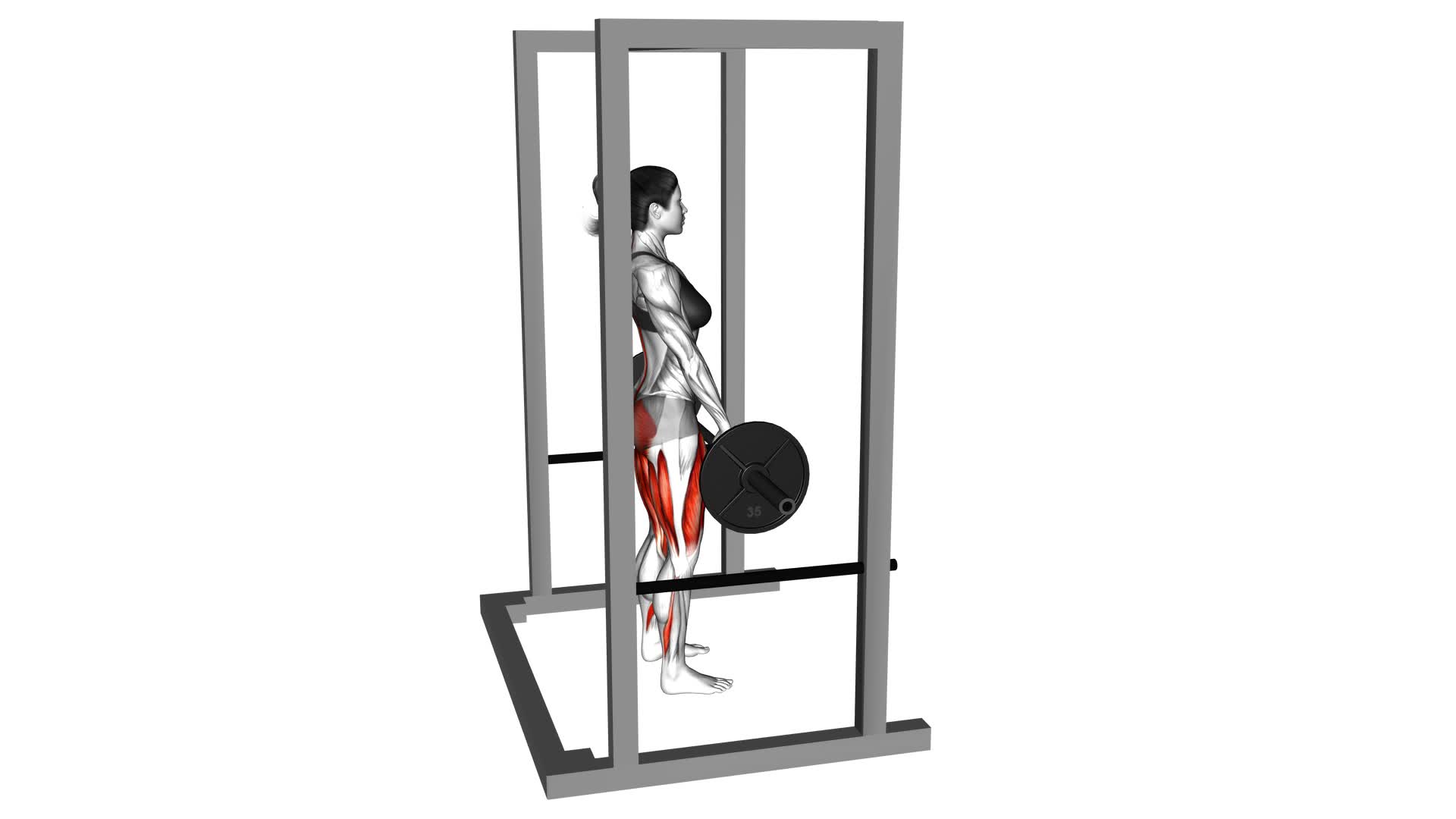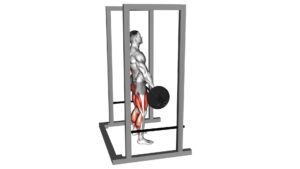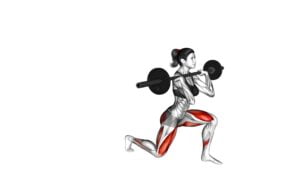Barbell Rack Pull (female) – Video Exercise Guide & Tips

Get ready to strengthen and tone your muscles with the Barbell Rack Pull.
Watch This Exercise Video
This video exercise guide and tips are specifically designed for females like you. Learn the proper form and technique, discover variations for different fitness levels, and avoid common mistakes.
With these tips, you'll increase your strength and progress in no time. Remember to follow safety precautions and prepare yourself for an effective Barbell Rack Pull workout.
Let's get started!
Key Takeaways
- Barbell Rack Pull can increase overall strength and power for females.
- It targets major muscle groups including the back, glutes, and legs.
- Proper form and technique are crucial for maximizing the benefits of this exercise.
- Gradually increasing weight and incorporating variations can help progress and improve strength.
Benefits of Barbell Rack Pull for Females
Improve your strength and posture with the Barbell Rack Pull, a powerful exercise that offers numerous benefits for females. The benefits of the barbell rack pull for women are vast and can greatly enhance your fitness journey. One of the key benefits is increased strength. By engaging your back, glutes, and legs, this exercise targets major muscle groups, helping you build overall strength and power.
Additionally, the barbell rack pull is an effective way to improve your posture. As you lift the barbell, you engage your core and back muscles, which can help correct any imbalances and promote a more upright posture.
To maximize the benefits of the barbell rack pull, it's important to focus on proper technique. Start by setting up the barbell at knee height, ensuring it's securely placed on the rack. Stand with your feet shoulder-width apart and grip the barbell with an overhand grip. Keep your back straight and engage your core as you lift the barbell, driving through your heels and squeezing your glutes at the top of the movement. Lower the barbell back down in a controlled manner, maintaining tension in your muscles throughout.
Proper Form and Technique for Barbell Rack Pull
To perform the barbell rack pull with proper form and technique, there are several key points to keep in mind.
First, it's important to maintain a straight back throughout the movement to avoid injury and maximize muscle engagement.
Second, ensure a secure grip and proper hand placement on the barbell to optimize strength and control.
Lastly, focus on breathing and engage your core muscles to stabilize your body and generate power.
Back Position Importance
Maintain a straight and neutral back position when performing the barbell rack pull to maximize effectiveness and prevent injury. Proper back position is crucial for muscle activation and ensuring that the correct muscles are being targeted during the exercise.
To achieve this, start by standing with your feet shoulder-width apart and your toes slightly pointed outwards. Engage your core and keep your spine straight, avoiding any rounding or excessive arching.
Imagine pulling your shoulder blades down and back, creating a slight squeeze between them. This will help to activate your upper back muscles and maintain a stable and strong position. Remember to keep your head in a neutral position, avoiding any excessive tilting or straining.
Grip and Hand Placement
Position your hands on the barbell with a firm grip, ensuring that your palms are facing towards your body. This grip and hand placement technique is crucial for maintaining control and maximizing grip strength during the barbell rack pull exercise. By gripping the barbell firmly, you engage the muscles in your forearms, enhancing your overall grip strength and stability. Placing your palms facing towards your body helps to activate the muscles in your back and shoulders, promoting proper form and technique.
Remember to keep your wrists straight and avoid bending or twisting them during the exercise. Once you have established a solid grip and hand placement, you can now focus on breathing and core engagement to further enhance your performance and protect your spine.
Breathing and Core Engagement
Breathe deeply and engage your core to maintain proper form and technique during the barbell rack pull exercise.
Breathing techniques and core activation are crucial for maximizing the benefits of this exercise and preventing injury.
As you set up for the rack pull, take a deep breath in, filling your lungs with air. Exhale as you lift the barbell, engaging your core muscles to stabilize your spine and maintain a neutral position.
Keep your abs tight throughout the movement, imagining that you're bracing for a punch. This will help protect your lower back and improve your overall strength and stability.
Remember to continue breathing throughout the exercise, inhaling as you lower the barbell and exhaling as you lift.
Variations and Modifications for Different Fitness Levels
Choose the appropriate variation of the barbell rack pull based on your fitness level.
There are several variations and modifications that can be made to suit different fitness levels and goals.
For beginners or those with lower fitness levels, it's recommended to start with the standard barbell rack pull. This involves placing the barbell on the rack at knee height and gripping it with an overhand grip. From here, you simply lift the barbell by extending your hips and knees, keeping your back straight and core engaged.
If you're more experienced or looking to increase the challenge, you can try the deficit barbell rack pull. This variation involves standing on a platform or step, which lowers the starting position of the barbell. This increases the range of motion and places more emphasis on the posterior chain muscles.
To further modify the exercise, you can adjust the height of the rack. Lowering the barbell to mid-shin height will place more emphasis on the hamstrings, while raising it to just below knee height will target the glutes and lower back.
Remember to always choose a weight that challenges you but allows you to maintain proper form. And as your fitness level improves, don't be afraid to progress to more challenging variations to continue challenging your muscles and achieving your fitness goals.
Common Mistakes to Avoid While Performing Barbell Rack Pull
To perform the barbell rack pull correctly, make sure to avoid these common mistakes.
First, be mindful of your grip width – using an incorrect grip can compromise your form and limit your strength.
Secondly, maintain a straight back posture throughout the exercise, avoiding any rounding or hunching.
Finally, focus on engaging your hips and driving them forward to generate maximum power and efficiency in the movement.
Incorrect Grip Width
Your grip width plays a crucial role in performing the Barbell Rack Pull exercise correctly. Improper technique and grip strength can greatly impact the effectiveness of this exercise. When gripping the barbell, make sure your hands are placed slightly wider than shoulder-width apart. This allows for proper engagement of the muscles in your back and upper body.
If your grip is too narrow, you may not be able to lift the weight properly, leading to a reduced range of motion and potential injury. On the other hand, if your grip is too wide, it can put excessive strain on your shoulders and elbows. Finding the right grip width will ensure that you can maintain proper form and maximize the benefits of the exercise.
Now, let's move on to the next section about the importance of maintaining a rounded back posture.
Rounded Back Posture
Maintain a strong and stable back position throughout the Barbell Rack Pull exercise to prevent rounding. It's crucial to maintain proper form to avoid injury and maximize the effectiveness of the exercise. Rounded back posture puts excessive stress on the spine and can lead to back pain or injury.
To maintain a proper form, focus on keeping your chest up, shoulders back, and spine neutral throughout the movement. Imagine a straight line from your head to your tailbone. Engage your core muscles and activate your glutes to support your back and maintain stability.
By keeping a strong and stable back position, you can ensure that your muscles are properly engaged and protected during the Barbell Rack Pull.
Now let's move on to the next common mistake to avoid: lack of hip drive.
Lack of Hip Drive
You should always remember to drive your hips forward during the Barbell Rack Pull exercise to maximize its effectiveness and prevent any potential mistakes.
Lack of hip drive is a common error that can hinder your progress and limit the benefits of this exercise. Proper hip mobility is crucial for generating power and strength during the movement.
To ensure proper hip drive, focus on activating your glutes as you initiate the movement. This will help engage the muscles in your posterior chain and allow for a more efficient and powerful lift.
Avoid relying solely on your upper body strength and instead, drive your hips forward forcefully to fully engage your glutes and maximize the benefits of the Barbell Rack Pull exercise.
Tips for Increasing Strength and Progressing in Barbell Rack Pull
To enhance your strength and advance in the Barbell Rack Pull, focus on progressive overload and proper form.
Progressive overload is a key technique for increasing strength. It involves gradually increasing the weight you lift over time. This challenges your muscles and forces them to adapt and grow stronger. Start with a weight that's challenging but manageable, and gradually increase it as you get stronger. This can be done by adding small increments of weight each week or every few workouts.
Another important aspect to consider is proper form. Maintaining proper form throughout the exercise is crucial for maximizing muscle activation and preventing injuries. When performing the Barbell Rack Pull, make sure to keep your back straight, engage your core, and drive through your heels. This will help you engage the target muscles, such as your glutes, hamstrings, and lower back, more effectively.
In addition to progressive overload and proper form, incorporating other progressing techniques can also help you increase strength in the Barbell Rack Pull. This can include variations of the exercise, such as deficit rack pulls or snatch grip rack pulls, which target different muscle groups and challenge your body in new ways. You can also focus on increasing the number of repetitions or sets you perform, or decreasing the rest time between sets. These techniques will keep your body adapting and progressing, leading to increased strength over time.
Safety Precautions and Preparing for Barbell Rack Pull
To ensure your safety and properly prepare for the Barbell Rack Pull exercise, it's important to take certain precautions and follow a few guidelines. Here are some safety measures and warm-up exercises to consider before starting your workout:
- Use proper form: Before attempting the Barbell Rack Pull, make sure you have mastered the correct form and technique. This will help prevent injuries and ensure optimal results.
- Start with lighter weights: Begin with lighter weights and gradually increase the load as you become more comfortable and confident with the exercise. This will allow your muscles to adapt and reduce the risk of strain.
- Warm up your muscles: Before starting any exercise, it's crucial to warm up your muscles. Engage in dynamic stretches and light cardio activities to increase blood flow and prepare your body for the workout.
- Use a spotter: If you're new to the Barbell Rack Pull or working with heavy weights, it's recommended to have a spotter nearby. A spotter can assist you in case you need help or encounter any difficulties during the exercise.
Frequently Asked Questions
How Many Sets and Repetitions Should I Perform for Barbell Rack Pull to See Results?
To see results with the barbell rack pull, you should perform multiple sets and repetitions. The number of sets and reps will depend on your fitness level and goals. Start with 3-4 sets of 8-12 reps and gradually increase the intensity as you get stronger.
The barbell rack pull offers various variations that target different muscle groups, helping you build strength in your back, glutes, and hamstrings. The exercise also improves grip strength and boosts overall power.
Can Barbell Rack Pulls Help to Improve My Deadlift Performance?
Barbell rack pulls can definitely help improve your deadlift performance. By incorporating different variations of the barbell rack pull into your training routine, you can target specific muscle groups and strengthen your overall pulling power.
The benefits of barbell rack pulls include increased back strength, improved grip strength, and enhanced overall lifting technique. Adding this exercise to your workout regimen can be a game-changer for your deadlifts, allowing you to lift heavier weights and achieve better results.
Are There Any Specific Warm-Up Exercises I Should Do Before Attempting Barbell Rack Pulls?
Before attempting barbell rack pulls, it's important to incorporate dynamic warm-up exercises into your routine. These exercises will help prepare your muscles and joints for the movement. Some examples include leg swings, arm circles, and hip rotations.
By warming up properly, you can reduce the risk of injury and improve your performance during the rack pulls.
Additionally, incorporating rack pulls into your workout routine can help strengthen your posterior chain and improve your deadlift performance.
How Often Should I Incorporate Barbell Rack Pulls Into My Workout Routine?
To maximize your gains, it's important to incorporate barbell rack pulls into your workout routine. These pulls offer numerous benefits, such as targeting your posterior chain and improving your deadlift strength.
You can vary your rack pulls by adjusting the height of the barbell and using different grips. Aim to include them in your routine at least once a week, ensuring proper form and gradually increasing the weight as you progress.
Can Barbell Rack Pulls Help to Target Specific Muscle Groups, Such as the Glutes or Hamstrings?
Barbell rack pulls are a great exercise for targeting specific muscle groups like the glutes and hamstrings. By incorporating different variations of the barbell rack pull into your workout routine, you can effectively activate and strengthen these muscles.
The benefits of barbell rack pulls include improved hip extension and increased overall strength.
To target the glutes, use a wider stance and focus on squeezing your glutes at the top of the movement.
For the hamstrings, focus on maintaining tension throughout the exercise.
Conclusion
In conclusion, the barbell rack pull is a highly effective exercise for females looking to increase their strength and develop their posterior chain muscles.
By maintaining proper form and technique, and making use of variations and modifications, individuals can tailor the exercise to their fitness level.
Avoiding common mistakes and following safety precautions will help prevent injuries.
With consistent practice and progression, females can achieve their strength goals and reap the benefits of the barbell rack pull.

Author
Years ago, the spark of my life’s passion ignited in my mind the moment I stepped into the local gym for the first time. The inaugural bead of perspiration, the initial endeavor, the very first surge of endorphins, and a sense of pride that washed over me post-workout marked the beginning of my deep-seated interest in strength sports, fitness, and sports nutrition. This very curiosity blossomed rapidly into a profound fascination, propelling me to earn a Master’s degree in Physical Education from the Academy of Physical Education in Krakow, followed by a Sports Manager diploma from the Jagiellonian University. My journey of growth led me to gain more specialized qualifications, such as being a certified personal trainer with a focus on sports dietetics, a lifeguard, and an instructor for wellness and corrective gymnastics. Theoretical knowledge paired seamlessly with practical experience, reinforcing my belief that the transformation of individuals under my guidance was also a reflection of my personal growth. This belief holds true even today. Each day, I strive to push the boundaries and explore new realms. These realms gently elevate me to greater heights. The unique combination of passion for my field and the continuous quest for growth fuels my drive to break new ground.







